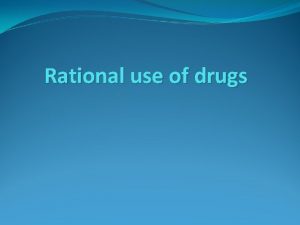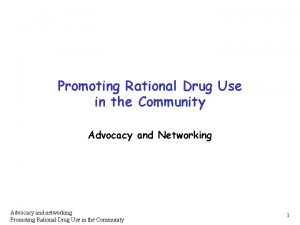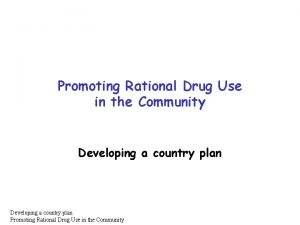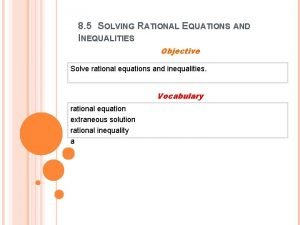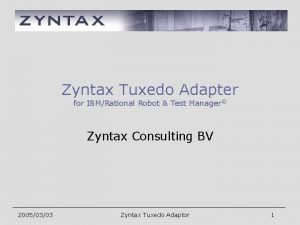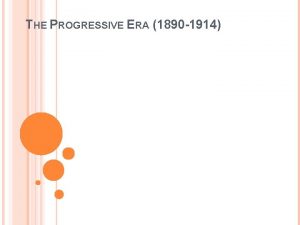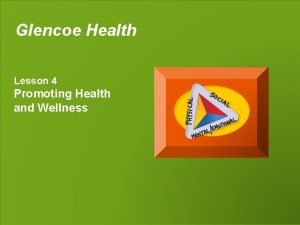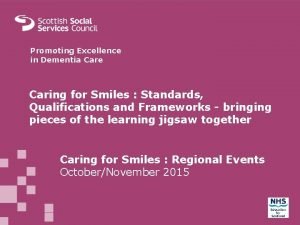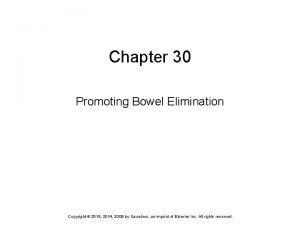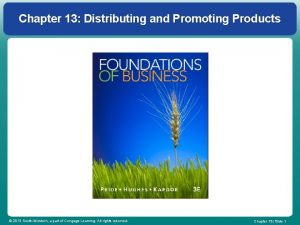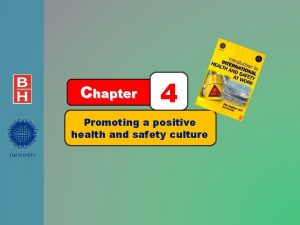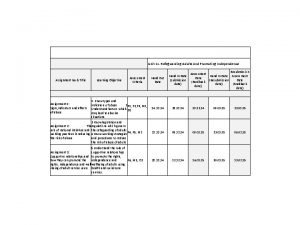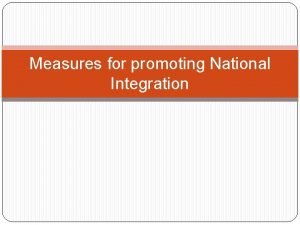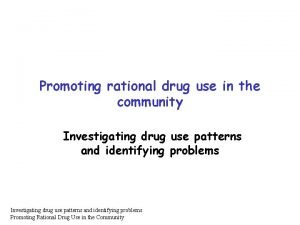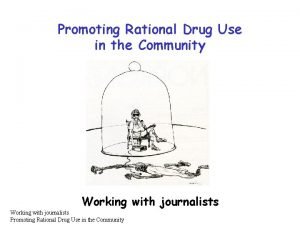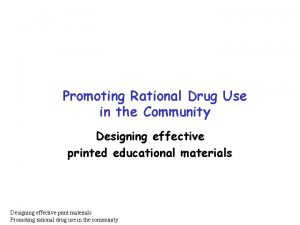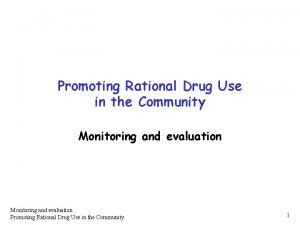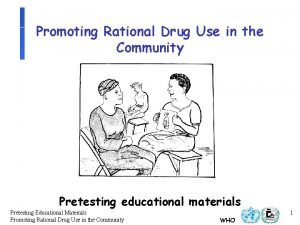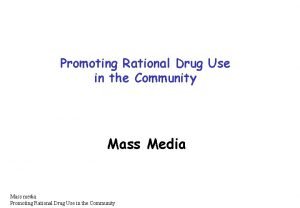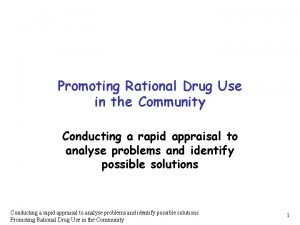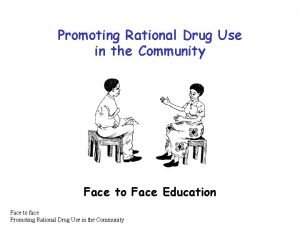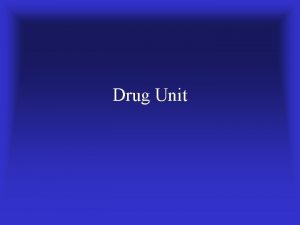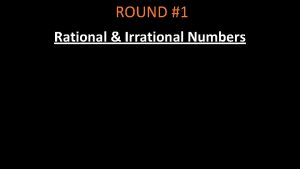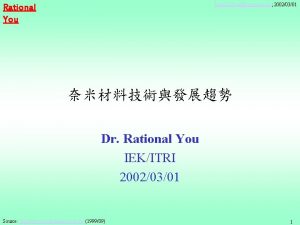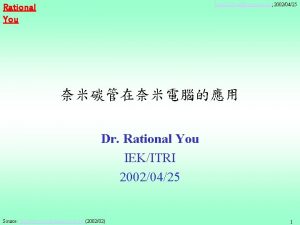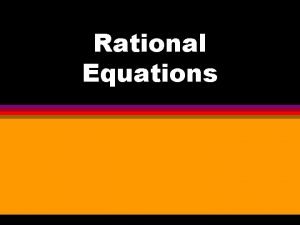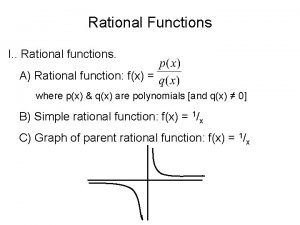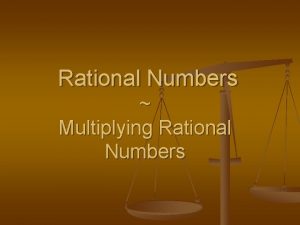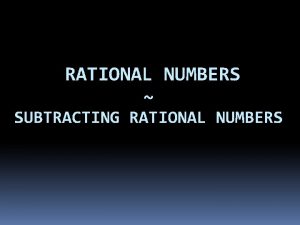Promoting Rational Drug Use in the Community Data




























- Slides: 28

Promoting Rational Drug Use in the Community Data analysis 1

Objectives: Session on Analysis § Describe in what ways quantitative and qualitative data can be processed § Describe how quantitative and qualitative data can best be analysed § Understand the differences between analysis of quantitative and qualitative data Data analysis Promoting rational drug use in the community WHO 2

Why plan for data-processing and analysis? § To make sure that all data needed to answer research questions are indeed collected § To avoid collecting superfluous data § To make sure you plan enough time and resources for processing and analysis § To make sure your research tools are adequate and easily processed Data analysis Promoting rational drug use in the community WHO 3

How to plan for data-processing and analysis? § Review research questions and data-collection tools § Decide how you want to present data: - qualitative: as texts - quantitative: as numbers § Make a list of variables for quantitative analysis § Decide on key drug use measures/indicators § Make dummy tables § Decide on data-master sheets for analysis of quantitative data § Make a list of key themes for qualitative analysis Data analysis Promoting rational drug use in the community WHO 4

Processing of quantitative data § Check if each questionnaire/interview form is complete § Sort data according to study populations (e. g. women – men; intervention community – control community) § Review all responses to categorical variables and refine the list of values for the categorical variable (you may need to add values you had not foreseen) § Assign codes to responses in questionnaires/interview forms Data analysis Promoting rational drug use in the community WHO 5

Variables: § Are defined as characteristics of persons or objects which can take on different values § Categorical variables are expressed in words/categories § Numerical variables are expressed in numbers § When planning for analysis of quantitative data, make a list of all variables and their values § Assign codes to categorical variables Data analysis Promoting rational drug use in the community WHO 6

Analysis of quantitative data § Summarise data on data master sheet § Determine missing values § Check data master sheet for consistency/mistakes § Calculate drug use measures/indicators § Make relevant frequency distributions § Fill in tables § Do statistical tests to test hypothesis on associations between variables Data analysis Promoting rational drug use in the community WHO 7

Examples of drug use measures § Percentage of illness episodes not treated § Percentage of illness episodes treated with traditional medicines § Percentage of illness episodes treated on health worker advice § Percentage of illness episodes treated in self-care with medicines § Percentage of fever episodes treated with chloroquine § Percentage of diarrhoea self-medicated with antibiotics Data analysis Promoting rational drug use in the community WHO 8

Examples of frequency distributions as way of presenting data: § Ten most commonly used medicines: calculated as relative percentage of total medications used § Main sources of medicines, calculated as the number of times medications are obtained from specific sources divided by total number of medications § Five most commonly used medicines for diarrhoea, expressed as percentage of total number of medications used to treat diarrhoea. Data analysis Promoting rational drug use in the community WHO 9

Example of an illness master sheet Data analysis Promoting rational drug use in the community WHO 10

Example of a medicine master sheet Data analysis Promoting rational drug use in the community WHO 11

Activity 1 § Review the two data master-sheets in pairs § Are any data missing: if yes, how will you deal with it? Delete the record? § How can you check if mistakes have been made during data-entry? § Have mistakes been made? § Is the data master-sheet well-designed? § How could the data master-sheets be improved? Data analysis Promoting rational drug use in the community WHO 12

Activity 2 § The data in the master-sheet allow for a comparison between men and women of types of drugs taken to the PRDUC course § Design a dummy table to present the data Data analysis Promoting rational drug use in the community WHO 13

Processing of qualitative data § Expand notes/transcribe tapes everyday § Add comments on non-verbal communication § Order data by type/group of informants § Read notes/transcriptions, read again Data analysis Promoting rational drug use in the community WHO 14

Qualitative analysis: an ongoing process § Read your notes, reflect more § Review your research questions: have they been answered: what do you still need to ask? § What unexpected issues/problems emerged? § Do you have sufficient data for each question; can you triangulate? Are there inconsistencies in data: do interviews confirm your observations or not? § Write down preliminary conclusions and queries § Go back to your informants: probe, ask them to explain and respond to your preliminary conclusions. Data analysis Promoting rational drug use in the community WHO 15

Rapid qualitative analysis § Review your list of themes for qualitative analysis, read your notes and find out if new issues emerged § Make matrices to summarise the data by theme. § Check if you have data on all your research questions § Beware of generalising: your data are not representative. § Describe your study population using key demographic variables (age, marital status, etc. ) Data analysis Promoting rational drug use in the community WHO 16

Analysis of textual data Make a list of codes Apply codes to texts Add codes as you go along Make analytical notes on the relation between factors; how things work § Make methodological notes: observations on how the methods influenced the results; ideas on new questions to ask § § Data analysis Promoting rational drug use in the community WHO 17

Coding of transcripts § Typ-fev § Type of fever § Cause-fev § Cause of fever § Tx-fev § Treatment of fever § P. eff-Tx § Perceived efficacy treatment Data analysis Promoting rational drug use in the community WHO 18

Summarizing qualitative data § Matrix § Flow charts § Diagrams Data analysis Promoting rational drug use in the community WHO 19

Example of an illness matrix Type of fever Data analysis Promoting rational drug use in the community Signs and symptoms Treatment WHO 20

Example of a treatment matrix Type of treatment Data analysis Promoting rational drug use in the community Perceived effect Perceived side-effect WHO 21

Example of a medicine source matrix Source of medicines Data analysis Promoting rational drug use in the community Perceived advantages Perceived disadvantages WHO 22

Example of a flow chart Data analysis Promoting rational drug use in the community WHO 23

Drawing and verifying conclusions Continuous process, based on : § Summary of data § Identifying trends § Identifying associations - causations § Consider confounding factors § Validation in group and individual discussions with informants Data analysis Promoting rational drug use in the community WHO 24

Cite your informants to illustrate § Select case-histories which are typical and illustrate findings § Use quotes to illustrate findings Data analysis Promoting rational drug use in the community WHO 25

Strategies to confirm findings Check for representativeness Check for observer bias Use multi-method Compare and contrast data Do additional research, include surveys to test hypothesis § Get feedback from communities and key informants § § § Data analysis Promoting rational drug use in the community WHO 26

Activity 3 Community sub-groups: § Review the illness-recall data in the SSI forms. § If you had collected 20 of such illnessrecalls: how can you summarize these data in one or two data master-sheet(s)? Data analysis Promoting rational drug use in the community WHO 27

Activity 3 Health institution sub-groups § Review the simulated client visit guidelines. § If you had done 20 such visits, how could you have summarized the data in a datamaster-sheet? Data analysis Promoting rational drug use in the community WHO 28
 9 rational use of drugs
9 rational use of drugs Objectives of rational drug use
Objectives of rational drug use Objectives of rational drug use
Objectives of rational drug use Methods of adulteration of crude drugs
Methods of adulteration of crude drugs 8-5 solving rational equations and inequalities
8-5 solving rational equations and inequalities Zyntax
Zyntax When was the progressive era? *
When was the progressive era? * Promoting services and educating customers
Promoting services and educating customers Promoting alternative thinking strategies
Promoting alternative thinking strategies Glencoe health and wellness
Glencoe health and wellness Promoting family earthquake preparedness
Promoting family earthquake preparedness Chapter 1 understanding health and wellness lesson 4
Chapter 1 understanding health and wellness lesson 4 Promoting racial literacy in schools
Promoting racial literacy in schools Lesson 4 promoting health and wellness
Lesson 4 promoting health and wellness Methods of promoting intrapreneurship leaving cert
Methods of promoting intrapreneurship leaving cert Keeping an infant safe and well section 7-3
Keeping an infant safe and well section 7-3 Promoting excellence in dementia care
Promoting excellence in dementia care Duty ethics example
Duty ethics example Chapter 7 promoting health and wellness
Chapter 7 promoting health and wellness Chapter 30 promoting bowel elimination
Chapter 30 promoting bowel elimination Chapter 13 distributing and promoting products
Chapter 13 distributing and promoting products Promoting services and educating customers
Promoting services and educating customers Health promoting schools model
Health promoting schools model Promoting active participation
Promoting active participation Promoting a positive health and safety culture
Promoting a positive health and safety culture Unit 11 safeguarding adults and promoting independence
Unit 11 safeguarding adults and promoting independence National integration and international understanding
National integration and international understanding Institutional support to an entrepreneur on the following
Institutional support to an entrepreneur on the following Health promoting school
Health promoting school
